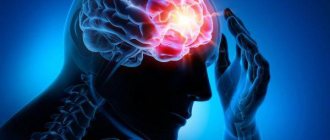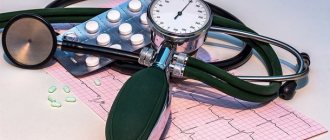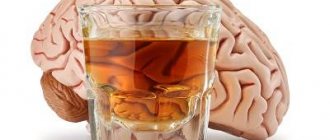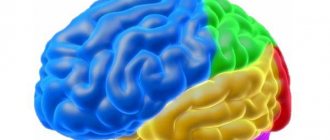Childbirth is certainly stressful for a child who has just been born. It is caused by large physical overloads (“pain attack”) that the baby experiences during contractions. In addition, after birth, the baby’s whole body changes its functioning.
This is due to the fact that:
* The baby finds himself in a completely different environment
, in which the temperature is lower than in the mother's womb.
* He is bombarded with a colossal amount of irritants
(sound, auditory, sensory, tactile and others).
* After birth, the child has a different way of breathing (pulmonary) and a new way of receiving nutrients.
The baby must adapt to all these changes, which is why he experiences borderline (physiological, transient, transitional) states.
What disorders are classified as prediabetes?
Prediabetes includes any of the early disorders of carbohydrate metabolism. This may be impaired fasting glucose (IFG) or impaired glucose tolerance (IGT), says an article by specialists from the Russian National Research Medical University named after N. I. Pirogov, published in the journal Medical Review.
The first national epidemiological cross-sectional study of the prevalence of T2DM in Russia (NATION) showed that early disorders of carbohydrate metabolism, such as IGT and NGT, are present in 19.3% of the Russian adult population aged 20-79 years.
What are the risk factors?
The NATION study demonstrated the association of carbohydrate metabolism disorders with age, body mass index (BMI), sedentary lifestyle and arterial hypertension. Scientists are actively discussing the role of obesity in the formation of early disorders of carbohydrate metabolism. Such disorders are diagnosed in more than half of overweight patients.
According to the all-Russian public organization of disabled people "Russian Diabetes Association", risk factors for the development of prediabetes are age over 35 years, obesity (BMI ≥ 25 kg/m2), the presence of close relatives (parents, brothers/sisters) with type 2 diabetes mellitus, habitually low physical activity, NGT or IGT. Also, the development of a borderline state can be caused by gestational diabetes (occurs during pregnancy), the birth of a large fetus, polycystic ovary syndrome, the presence of cardiovascular diseases, arterial hypertension (from 140/90 mm Hg) or taking medications to lower blood pressure, the indicator of “good” cholesterol (HDL) is less than 0.9 mmol/l and/or the level of triglycerides from 2.82 mmol/l.
According to the BME, prediabetes (also known as potential diabetes mellitus) can be detected in an identical twin of a person with T2DM, in a person whose both parents are diabetic, or one parent is sick and there are patients in the family line of the other. There is also a predisposition in women who gave birth to a live or stillborn child weighing more than 4.5 kg, as well as who gave birth to a stillborn child with hyperplasia of the islets of Langerhans (increase in the size or number of pancreatic islets) in the absence of erythroblastosis (a disease due to incompatibility of the fetal blood type and mother).
One step away from diabetes. What is prediabetes and how to identify it Read more
General approaches to the prevention and treatment of borderline states
In the treatment of mental illnesses, all aspects of the organization of psychiatric care, drug and material support for medical institutions, qualifications and training of doctors and medical personnel are concentrated in the most complete form. Differential-diagnostic, clinical-organizational, therapeutic and rehabilitation approaches to providing assistance to patients with mental illnesses at the present stage of development of specialized psychiatric services not only complement each other, but also allow each of these relatively independent areas of medical care to be “realized.” The absence of one or another link or its “blocking” for a variety of reasons affects the entire system of care for the mentally ill and in some cases can make it completely unsuitable.
Therapy for any patient with a borderline condition includes a complex of direct medical measures (examination and diagnosis, provision of emergency assistance if necessary, course therapy using various medications, psychotherapy, physiotherapy, other therapeutic agents and methods) and sociotherapeutic measures aimed at his social -psychological correction and rehabilitation.
Patient therapy includes:
— a complex of direct medical measures (examination, diagnosis, emergency care, course treatment);
— sociotherapeutic activities;
— medical and psychological correction and rehabilitation.
The “points of application” of therapeutic factors to pathogenetic links that determine the development of psychopathological manifestations of a neurotic level indicate wide possibilities for the justified implementation of therapeutic, preventive (primary, secondary) and compensatory and rehabilitation measures. Their use provides differentiated therapy for patients with various borderline conditions.
Therapeutic effects can be aimed at:
— the causes of the disease (etiological therapy);
— pathogenetic mechanisms that determine the course of the disease;
— compensatory mechanisms.
Whatever treatment and rehabilitation measures are carried out, as in other areas of medicine, in psychiatry they must be carried out on a solid legal basis and taking into account generally accepted ethical standards. The World Association of Psychiatrists, at its congress held in August 1996 in Madrid, adopted a special declaration in this regard. It emphasizes that psychiatrists in their work should always be guided by respect for and care for the patient, showing an “individual sense of responsibility.” To this end, the Madrid Declaration establishes general principles of conduct for psychiatrists. The main ones are given below. [Declaration of Madrid. August 1996. Madrid, s. 4 (translated with abbreviations).]
1. Psychiatry is a medical discipline concerned with the provision of treatment for mental disorders... Psychiatrists must develop ways of therapeutic intervention that least restrict the freedom of the patient. At the same time, if necessary, one should strive to obtain advice from competent colleagues.
2. Psychiatrists are obliged to keep up with scientific advances, expanding their knowledge and transferring it to other specialists.
3. The patient must be considered a participant in the therapeutic process. The doctor-patient relationship should be based on mutual trust and respect...
4. Information obtained in the therapeutic relationship must remain confidential and be used only and exclusively for the purpose of improving the mental health of the patient. Psychiatrists are prohibited from using this kind of information for personal purposes, as well as for “financial and scientific benefits.”
A special place for primary and secondary prevention, as well as for the treatment of patients with borderline conditions, belongs to mental hygiene. This concept arose and spread quite quickly at the beginning of the 20th century. in the USA thanks to CW Beers, who suffered from mental illness and, after being discharged from a psychiatric hospital, did a lot for the reform of psychiatric care and mental hygiene. With the support of progressive psychiatrists and psychologists, the first mental hygiene society was created in the state of Connecticut in May 1908. A year later, a national committee on mental hygiene was founded in New York (its secretary was S. Beers for a long time), which became an authoritative coordinator of the activities of doctors in the field of prevention and early diagnosis of mental disorders among the population, as well as in eliminating the causes that cause them. It is important to emphasize that the founders of psychohygienic research in the USA A. Meyer, S. Paton, S. Salmon and others considered mental hygiene an integral part of preventive medicine. Psychohygienic committees and councils were created at the beginning of the century not only in the USA, but also in Canada, England, France, Belgium, in a number of other countries, and a little later in Germany. The issues addressed by these public and governmental organizations were broad and heterogeneous (improving the mental health of society through improving social conditions, industry, environment, education; studying the causes of mental illness from the point of view of their prevention; combining the preventive activities of psychiatrists and representatives of general medicine, etc.) d.).
In our country in the first half of the 20th century. Two main psychohygienic trends in that period began to develop intensively. Firstly, a preventive dispensary psychiatric examination, including “social, psycho-hygienic, psychopathological study of the individual with the most comprehensive examination of the whole organism” (Rozenshtein L.M., 1929). It was on the basis of this direction that psychiatric dispensaries were subsequently formed (quite soon they lost interest in issues of mental hygiene and focused their activities on outpatient treatment and monitoring of the mentally ill). Secondly, preventive practice, which aimed to study and eliminate various factors affecting mental health (psychosanitation, psychosocial, psychophysical, industrial and other factors). This trend has largely received a “rebirth” in our country in recent years, as evidenced by numerous data discussed at congresses of Russian psychiatrists and at a number of major meetings held in 1992-1999. As a result, in a number of regions a fairly clear system of preventive psychohygienic work of psychiatrists at industrial enterprises and in general somatic medical institutions has developed.
A therapeutic plan developed by a doctor in a hospital or out-of-hospital setting for each patient can be most rationally constructed with a mandatory differentiated clinical and psychopathological assessment of the patient’s condition and taking into account the potential capabilities of available therapeutic agents and methods. Comparing one with the other is the basis for moving away from the “trial and error” method when prescribing psychopharmacological drugs and other means and methods of therapy. When developing an individual treatment plan, it is necessary to formulate the purpose of the entire treatment process and its individual sequential stages. Despite the apparent obviousness of what has been said, in widespread medical practice the choice of a particular therapeutic agent, its doses and methods of administration is often carried out without a clear system of scientific justification, with a certain amount of empiricism and the doctor’s own experience.
Treatment of a patient suffering from borderline mental disorders can be directed to:
- on the causes of the disease (etiological therapy);
— on the pathogenetic mechanisms that determine the occurrence and course of the disease (pathogenetic therapy);
- on compensatory mechanisms that indirectly contribute to the formation of adaptation to the ongoing disease process (compensatory therapy).
Etiological therapy itself is rarely used in psychiatry, mainly due to the uncertainty of the factors that have causal significance for the occurrence of major mental illnesses. The most commonly used pathogenetic therapy is aimed at certain known or hypothetical mechanisms of the disease. Typically, pathogenetic therapeutic measures are closely related to compensatory therapy.
Etiological therapy , which helps eliminate the cause of the disease and is used in the treatment of mental disorders, includes activities carried out to eliminate various infectious, somatic, neurological diseases, the consequences of brain injuries, accompanied by both psychotic and non-psychotic psychopathological manifestations. Using the entire arsenal of modern therapeutic methods and means (antimicrobial, antiparasitic, antiviral, cardiovascular drugs, nootropics, hormones, neurosurgical methods, etc.), eliminating the cause and direct consequences of the underlying disease or injury, it is possible to achieve a reduction in the accompanying their mental disorders. In the history of psychiatry, this has been most clearly observed in the treatment of progressive paralysis. Fundamental in this case was the identification of the connection between previous syphilis and progressive paralysis, which occurs with a specific picture of nervous and mental disorders. Malarial therapy for progressive paralysis, proposed in 1917 by J. Wagner Tauregg, modern means of preventing syphilis, its early and effective treatment with currently available means have deprived psychiatrists of a contingent of patients with such frequent and fatal diagnoses in the recent past as syphilitic neurasthenia, syphilitic meningitis, hallucinatory , paranoid and many other forms of syphilis.
Etiological therapy may also include some methods of psychotherapy and socio-psychological correction of the condition in patients with psychogenic disorders. Elimination of the psychotraumatic situation that caused neurotic reactions and states or a change in the patient’s attitude towards it usually directly, in close temporal connection, also contributes to the reverse development of psychopathological manifestations. The prescription of medications, including the entire arsenal of psychopharmacological drugs, in these cases can be classified as auxiliary therapeutic measures.
Pathogenetic therapy for mental illnesses is, as a rule, nonspecific: fairly effective drugs and therapeutic measures are used for various diseases and psychopathological conditions. The prescription of psychopharmacological drugs and other therapeutic agents primarily contributes to the reduction of those syndromes and symptoms to which they have tropism, i.e. which have a clinically detectable predominant therapeutic effect. Following this, the entire clinical picture normalizes with the reverse development of the remaining symptoms. At first glance, this is consistent with the well-known statement about target symptoms in relation to the action of psychotropic drugs, according to which the most adequate assessment of the effectiveness of drugs in psychiatry is associated with the modification of individual symptoms under their influence. However, target symptoms are only the first guideline for selecting, in the figurative expression of GE Kuhne, H. Rennert (1965), the key (the necessary medicine) to the lock (to the existing mental disorder). The severity of the effect each time depends on the characteristics of the symptom and its place in the dynamics of the painful picture as a whole. This understanding of the nature of therapeutic “target symptoms” is probably the most correct for determining the essence of the symptomotropic and nosotropic effects of all “psychoactive” therapeutic agents and methods. It is unlikely that one should try to put their action into the framework of “symptomatic” or “syndromological”; it is most accurately assessed as selective pathogenetic. This means that, by selectively influencing a symptom, the therapeutic effect thereby influences one of the links in the pathogenetic chain of the pathological process.
Medicines used in psychiatry are not nosotropic. However, the maximum therapeutic effect when prescribing them is achieved when the “psychotropicity” of the drug finds the most favorable “soil” in the nature of the psychopathological structure of the condition.
The therapeutic effect on various pathogenetic links in mental illness in medical practice can only be judged indirectly. Psychopharmacological drugs, as well as drugs that cause general biological effects, do not directly affect psychological and psychopathological phenomena. Their clinical effect is indirect through the so-called primary properties of the individual as an organism, realizing the potential influence of psychoactive drugs on the pathogenetic links of painful conditions.
Compensatory therapy includes various biological and sociotherapeutic influences that contribute not to the elimination of the cause of the disease (etiological therapy) or the direct “correction” of one or another of its pathogenetic mechanisms (pathogenetic therapy), but to the stimulation of compensatory processes, due to which many painful manifestations are weakened and leveled. Many medications and therapeutic methods have a compensatory effect in mental illness - cardiovascular, dehydration, hypnotics, actoprotectors, other psychotropic drugs with a nonspecific stimulating or sedative effect, rational and other methods of psychotherapy, social rehabilitation.
The choice of therapeutic agents for each of the three areas of treatment - etiological, pathogenetic and compensatory - is based on the need to develop an individual treatment regimen for each individual patient.
Methods and means used in psychiatric practice include therapy with psychopharmacological (psychotropic) drugs (neuroleptics, tranquilizers, antidepressants, psychostimulants, nootropics and some others), which occupies a leading place in the treatment of major mental illnesses, psychotherapy, fasting-dietary therapy, reflexology etc. Along with this, for the treatment of both psychosomatic disorders and major mental illnesses, the entire arsenal of medications, physiotherapy, spa treatment, etc. is widely used. A special place in psychiatric practice belongs to the system of rehabilitation of sick and disabled people.
Each of these methods and means has its own indications and contraindications for use. They are based both on the empirical experience of clinical psychiatry and on scientifically based evidence of the influence on the mechanisms that determine the pathological state.
Various methods and means create ample opportunities for the well-founded development of an individual therapeutic plan. In this case, one should take into account the dynamics of the disease as a whole and the leading psychopathological symptom complex: somatic condition; the effectiveness of previous therapy; side effects and complications previously observed; concomitant diseases, etc.
How is prediabetes diagnosed?
The Russian Association of Endocrinologists (RAE) has defined criteria for diagnosing prediabetes. To confirm early disorders of carbohydrate metabolism, an oral glucose tolerance test (OGTT) is performed. The patient's blood is drawn in the morning after 8-14 hours of fasting. Then he is given to drink 75 g of glucose dissolved in 250-300 ml of water, and two hours later the blood is taken again. Glucose tolerance is considered impaired if the concentration of this substance in venous blood taken on an empty stomach is less than 7 mmol/l, and in blood taken two hours after OGTT - from 7.8 to 11 inclusive. Impaired fasting glucose is diagnosed if the fasting glucose concentration is from 6.1 to 6.9 mmol/l inclusive, and after OGTG - less than 7.8.
Also, the indicator of glycated hemoglobin (HbA1C) can serve as a criterion for diagnosing early disorders of carbohydrate metabolism. The RAE does not use it, and the American Diabetes Association considers prediabetes a condition in which the level of glycated hemoglobin is 5.7-6.4% inclusive.
Article on the topic
Cage in a case. New technology will allow the body to produce insulin
Setting boundaries[ | ]
The state border is established, as a rule, on the basis of treaties between neighboring states, and where the territorial waters of a state are in contact with the open sea, by internal legislative acts of coastal states in accordance with international law.
Territorial delimitation between states is carried out in stages, during the delimitation and demarcation of the border.
In interstate practice, orographic, geometric and geographical state boundaries are known.
- An orographic boundary
is a line drawn along natural boundaries, taking into account the terrain, mainly along a mountain watershed and river beds. - The geometric boundary
crosses the area without taking into account its topography (bypassing populated areas). - A geographic line
passes through certain geographic coordinates (may coincide with a parallel or meridian). Geographic boundaries drawn along parallels and meridians are found in Africa and America, where they were established by the metropolitan states for the colonies.
According to the current Law on the State Border of the Russian Federation, the passage of the state border of the Russian Federation is usually established:
- on land - along characteristic points, relief lines or clearly visible landmarks;
- at sea - along the external border of the territorial sea of the Russian Federation;
- on navigable rivers - in the middle of the main fairway or thalweg of the river;
- on non-navigable rivers and streams - in their middle or in the middle of the main branch of the river;
- on lakes and other bodies of water - along an equidistant, median, straight or other line connecting the exits of the state border to the shores of the lake or other body of water;
- on water reservoirs and other artificial reservoirs - in accordance with the state border line that ran in the area before it was flooded;
- on bridges, dams and other structures passing through rivers, streams, lakes and other bodies of water - in the middle of these structures or along their technological axis, regardless of the passage of the state border on water[2].
What is the risk of prediabetes progressing to diabetes?
Prediabetes is an indicator that a patient is at high risk of developing the disease. According to research, patients with prediabetes are five times more likely to develop the disease than those who have not gone through this stage. It has been established that annually in 5-10% of patients IGT develops into diabetes mellitus. Within five years, the transition occurs in 20-34% of patients with prediabetes, and when combined with IGT, in 38-65%.
Meanwhile, doctors agree that the development of prediabetes is reversible. Patients who have early disorders of carbohydrate metabolism should undergo a full examination and, together with a doctor, understand the processes that have begun in the body. Next, you need to develop an action plan that can influence the condition and change the indicators in the right direction.
Natural statin. How does magnesium help lower cholesterol? More details
Border designation[ | ]
Main article: Demarcation
Border between the Netherlands (left) and Belgium (right), the village of Baarle Treriksroset (junction of the borders of Finland, Norway and Sweden)
The state border line on the ground is indicated by clearly visible boundary markers. In some cases, other signs may be used, such as markings on asphalt.
Cleaning strip
- a strip of terrain up to 10 meters wide (4-5 m in each direction from the demarcation line of the state border), intended for the installation of border markers on land sections of the border. In areas covered with forest or shrubs, it is made in the form of clearings. In some international treaty documents, the clearing strip is called a border clearing[3].
Fastening strip
— a strip of terrain 40 m wide (20 m in each direction from the border of the clearing strip), allocated to ensure the safety of boundary markers.
Any work in the fastening zone can only be carried out by agreement between the relevant authorities of neighboring states[4]. Slovak-Ukrainian border. A dividing sign and two border pillars - Slovak and Ukrainian. There is a fence on both sides with video surveillance. Border crossing in Kyrgyzstan on the border with Kazakhstan. Border of Germany and Austria. Both countries are part of the Schengen Agreement, crossing the border is free, it is actually not guarded. The border between Israel and Jordan along the Jordan River in the area of the settlement of Kathir al-Yahud, 9 km north of the Dead Sea. Photo from the Israeli shore, 2020
How is prediabetes treated?
Patients with prediabetes should pay special attention to prevention so that it does not develop into T2DM and lead to the development of cardiovascular complications. In domestic and foreign recommendations for the prevention of diabetes, the main role is given to lifestyle changes. Patients with early carbohydrate metabolism disorders and excess weight should reduce body weight by limiting the intake of fats and simple carbohydrates and engaging in regular moderate physical activity (walking, climbing stairs) for at least 150 minutes per week. Even a small decrease in body weight - by 5-7% - leads to improved glycemic indicators and a reduction in cardiovascular risks. Research confirms that a 10% reduction in body weight reduces the risk of developing T2DM in the future by 80%. It is also recommended to limit alcohol consumption and smoking, and sleep at least seven hours a day.
However, not all patients are able to achieve normal blood sugar levels with a strict diet. Therefore, drug therapy may be indicated for such people.











